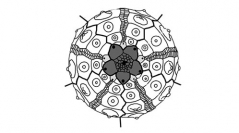

 Comptes Rendus Palevol
2 (6-7) - Pages 399-412
Comptes Rendus Palevol
2 (6-7) - Pages 399-412The tendency of the periproct to move outside the apical system occurred in eight independent sea urchins lineages, but only one succeeded. The origin of the anterior-posterior axis in irregular echinoids results from that successful attempt, and is primarily achieved by eccentricity of the periproct. The mechanism by which this occurs is best understood through synthesis of data from embryology, paleontology, and phylogenetics. In irregular echinoids, the complete escape of the periproct from the apical system (exocyclism) is a consequence of changes in the embryological sequence that governs periproctal eccentricity. The adaptative significance of this change is discussed.
Developmental constraints, embryology, exocyclism, irregular echinoids